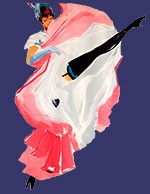
Moulin Rouge is a famous cabaret in Paris which was at first an important gathering place of aristocracy and rich industrialists, but eventually evolved to become one of the most important tourist attractions in the city. The home of the famous can-can dance, its performance evolved over time in line with the tastes of the audience, to become a tourist attraction and mostly dedicated to these visitors.
 Moulin Rouge was founded in 1889 by a French entrepreneur Charles-Joseph Zidler and a Spanish entrepreneur Joseph Oller. These two great businessmen had a clear vision of the customers’ tastes and apart from Moulin Rouge opened numerous other activities in Paris. Moulin Rouge was opened in the area of Paris at the base of the famous Montmartre hill, which was at that time famous for a different kind of atmosphere. In comparison with the rest of the city, this area was characterized by a cheerful atmosphere and its festivities and it was very popular among artists and all social classes. Therefore, two entrepreneurs had an idea to open a place where the rich citizens of Pairs could seek entertainment in this popular area of Paris.
Moulin Rouge was founded in 1889 by a French entrepreneur Charles-Joseph Zidler and a Spanish entrepreneur Joseph Oller. These two great businessmen had a clear vision of the customers’ tastes and apart from Moulin Rouge opened numerous other activities in Paris. Moulin Rouge was opened in the area of Paris at the base of the famous Montmartre hill, which was at that time famous for a different kind of atmosphere. In comparison with the rest of the city, this area was characterized by a cheerful atmosphere and its festivities and it was very popular among artists and all social classes. Therefore, two entrepreneurs had an idea to open a place where the rich citizens of Pairs could seek entertainment in this popular area of Paris.
In February 1915, the building of the theatre was completely destroyed. After the reconstruction works the theatre was re-opened in 1921. During the Second World War, German troops occupied the entire country. The Moulin Rouge theatre was opened throughout the occupation period, since it was a very popular place for the German army officers. In 1944, just several days after Paris was liberated, Edith Piaf performed in Moulin Rouge and since she was also performing for German officers she was considered a traitor by many at that time.
 Toulouse-Lautrec was a painter and illustrator who belonged to the Post-Impressionist artistic movement who was associated with Moulin Rouge. He was of aristocratic origins but he suffered from severe health problems, most probably due to the fact that his grand mothers were sisters and because of inbreeding family history. When Moulin Rouge opened, Toulouse-Lautrec accepted to draw numerous promotional posters for the theatre. Even though this activity was not appreciated by other artists, he continued with his work. On the other hand, he always had a table at the theatre and here he was allowed to exhibit his artwork.
Toulouse-Lautrec was a painter and illustrator who belonged to the Post-Impressionist artistic movement who was associated with Moulin Rouge. He was of aristocratic origins but he suffered from severe health problems, most probably due to the fact that his grand mothers were sisters and because of inbreeding family history. When Moulin Rouge opened, Toulouse-Lautrec accepted to draw numerous promotional posters for the theatre. Even though this activity was not appreciated by other artists, he continued with his work. On the other hand, he always had a table at the theatre and here he was allowed to exhibit his artwork.
Interesting facts